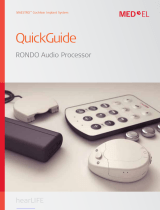Cochlear Nucleus 7 is an advanced sound processor that helps you hear better by directly stimulating the auditory nerve. With its powerful features, it can help you understand speech more clearly, enjoy music, and connect with your loved ones. It allows you to change programs, adjust volume and sensitivity, control True Wireless™ Accessories, and activate telecoil.
Cochlear Nucleus 7 is an advanced sound processor that helps you hear better by directly stimulating the auditory nerve. With its powerful features, it can help you understand speech more clearly, enjoy music, and connect with your loved ones. It allows you to change programs, adjust volume and sensitivity, control True Wireless™ Accessories, and activate telecoil.















-
 1
1
-
 2
2
-
 3
3
-
 4
4
-
 5
5
-
 6
6
-
 7
7
-
 8
8
-
 9
9
-
 10
10
-
 11
11
-
 12
12
-
 13
13
-
 14
14
-
 15
15
Cochlear Nucleus 7 User manual
- Type
- User manual
- This manual is also suitable for
Cochlear Nucleus 7 is an advanced sound processor that helps you hear better by directly stimulating the auditory nerve. With its powerful features, it can help you understand speech more clearly, enjoy music, and connect with your loved ones. It allows you to change programs, adjust volume and sensitivity, control True Wireless™ Accessories, and activate telecoil.
Ask a question and I''ll find the answer in the document
Finding information in a document is now easier with AI
Related papers
Other documents
-
 MED-EL RONDO Quick Manual
MED-EL RONDO Quick Manual
-
Atmel ARM Thumb AT91 User manual
-
Invacare Storm 4 Series User manual
-
Invacare TDX SP2 series User manual
-
Invacare XTR Series User manual
-
Philips DVDR70/001 User manual
-
Solid State Logic Sigma Delta User manual
-
Vicon Kollector Strike DVR User manual
-
Philips DVD 623 User manual
-
Vicon Virtual Matrix Display Controller (VMDC) User manual















